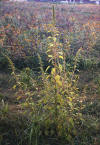| USDA ARS Memorandum, Richard W. Spjut to Curators, 13 June 1996. Return of Amaranth Loans with Key to Cultivated and Similar Species. 4 pp. and 2 pp. Notes and References. |
Amaranthus albus |
|
Amaranthus fimbriatus |
|
|
Amaranthus hybridus
|
Amaranthus palmeri |
|
Lipkin A., V. Anisimova, A. Nikonorova, A. Babakov, E. Krause, M. Bienert, E. Grishin and T. Egorov. 2005. An antimicrobial peptide Ar-AMP from amaranth (Amaranthus retroflexus L.) seeds. Phytochemistry. 66(20): 2426–2431. “A 30-residue antimicrobial peptide Ar-AMP was isolated from the seeds of amaranth Amaranthus retroflexus L. essentially by a single step procedure using reversed-phase HPLC, and its in vitro biological activities were studied. The complete amino acid sequence of Ar-AMP was determined by Edman degradation in combination with mass spectrometric methods. In addition, the cDNA encoding Ar-AMP was obtained and sequenced. The cDNA encodes a precursor protein consisting of the N-terminal putative signal sequence of 25 amino acids, a mature peptide of 30 amino acids and a 34-residue long C-terminal region cleaved during post-translational processing. According to sequence similarity the Ar-AMP belongs to the hevein-like family of antimicrobial peptides with six cysteine residues. In spite of the fact that seeds were collected in 1967 and lost their germination capacity, Ar-AMP retained its biological activities. It effectively inhibited the growth of different fungi tested: Fusarium culmorium (Smith) Sacc., Helminthosporium sativum Pammel., King et Bakke, Alternaria consortiale Fr., and Botrytis cinerea Pers., caused morphological changes in Rhizoctonia solani Kühn at micromolar concentrations and protected barley seedlings from H. sativum infection.” Martirosyan D. M., L. A. Miroshnichenko, S. N. Kulakova, A. V. Pogojeva and Vi. I. Zoloedov. 2007. Amaranth oil application for coronary heart disease and hypertension. Lipids Health Dis. 6:1. “Cardiovascular disease (CVD) is the Nation's leading killer for both men and women among all racial and ethnic groups. Development and progression of CVD is linked to the presence of risk factors such as hyperlipidemia, hypertension, obesity, and diabetes mellitus. It is known that cholesterol is an indicator of increased risk of heart attack and stroke. Low-density cholesterol (LDL) above 130 mg/dl high-density cholesterol (HDL) cholesterol below 35 mg/dl and total blood cholesterol above 200 mg/dl are indicators of problematic cholesterol. Proper ranges of cholesterol are important in the prevention of CVD. It has been suggested that a reduction in the consumption of saturated and an increase in unsaturated fatty acids is beneficial and prevents CVD. Amaranth grain contains tocotrienols and squalene compounds, which are known to affect cholesterol biosynthesis. The cholesterol precursors squalene, lanosterol and other methyl sterols, reflect cholesterol synthesis 123, whereas plant sterols and cholestanol, a metabolite of cholesterol, reflect the efficiency of cholesterol absorption in normal and hyperlipidemic populations 456. Qureshi with co-authors 7 showed that feeding of chickens with amaranth oil decreases blood cholesterol levels, which are supported by the work of others 8. Previously, we have shown that Amaranth oil modulates the cell membrane fluidity 9 and stabilized membranes that could be one reason as to why it is beneficial to those who consume it. It is known that in hypertension, the cell membrane is defective and hence, the movement of the Na and K ions across the cell membranes could defective that could contribute to the development of increase in blood pressure. Based on these properties of amaranth oil we hypothesize that it could be of significant benefit for patients with CVD.” Rivillas-Acevedo L. A. and M. Soriano-García. 2007. Isolation and Biochemical Characterization of an Antifungal Peptide from Amaranthus hypochondriacus Seeds. J. Agric. Food Chem. 55(25):10156–10161. “An antifungal peptide, Ay-AMP, was isolated from Amaranthus hypochondriacus seeds by acidic extraction and then purified by reverse-phase high-pressure liquid chromatography. The molecular mass of this peptide, as determined by mass spectrometry, is 3184 Da. The peptide belongs to the superfamily of chitin-binding proteins, containing a single cysteine/glycine-rich chitin-binding domain, and it was found that Ay-AMP degrades chitin. Ay-AMP inhibits the growth, at very low doses, of different pathogenic fungi, such as Candida albicans, Trichoderma sp., Fusarium solani, Penicillium chrysogenum, Geotrichum candidum, Aspergillus candidus, Aspergillus schraceus, and Alternaria alternata. Ay-AMP is very resistant to the effect of proteases and heating; however, it showed an antagonistic effect with CaCl 2 and KCl.” |
|





